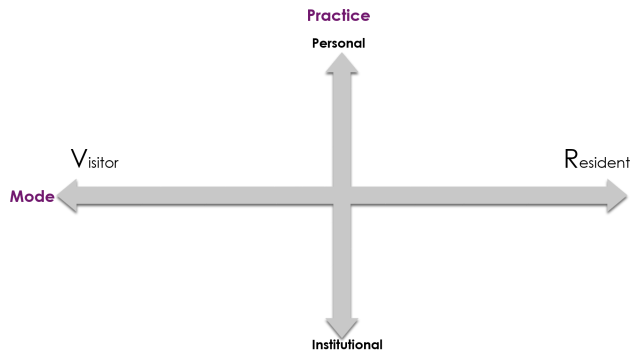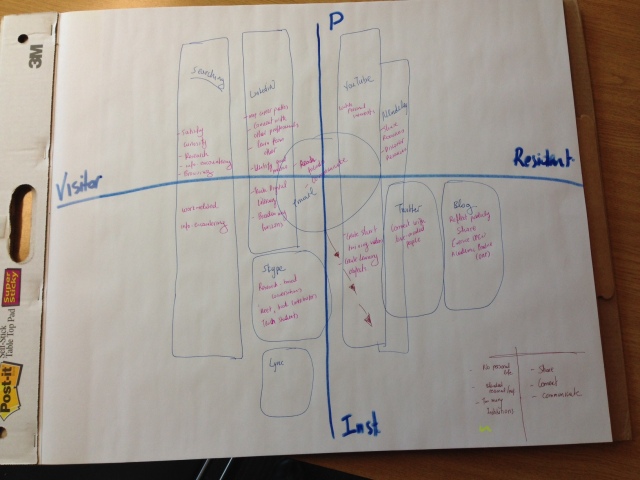On Monday 23rd of March I had a great opportunity to participate in a workshop, delivered by Donna Lanclos at the Imperial College Library, on Ethnographic Research Methods.
Donna has a unique professional identity; she is an Anthropologist employed by an Academic Library, the J. Murrey Atkins Library, UNC Charlotte, and applies Anthropological Research in this context.
There are too many takeaways from this workshop, the first one being that Librarians have a lot to learn from engaging with Research Methods in general and Ethnography in particular.
Here are some of my major reflective moments:
What is a Visitor and what is a Resident
The workshop started with disentangling the notions of Visitors and Residents developed by David White.
Very often we think of a digital space in conjunction with our persona and the kind of identity we develop. There has been a lot of buzz in recent years around visitors, residents, natives, immigrants and so forth but this session came to clarify the original thinking behind these notions as a mode of behaviour, motivation and presence in a digital space.
Visitors and Residents continuum (White & Le Cornu, 2011, p.7) Image is linked to the original.
So being in a Visitor mode means that we interact in a digital space without leaving a trace by means of contributing. For instance, we have a Twitter account but we use it as a news-stream or observe what others are doing without posting anything.
At the other end of the spectrum we operate as Residents when we contribute and have an active presence in a digital space.
Let’s map our engagement
Talking about digital engagement in an abstract way does not create a massive impact or any major reflective thinking. What happens though if we visualise this engagement?
Donna asked us to map our behaviours illustrating our digital presence across four axes (as per figure below)

Adapted from http://daveowhite.com/vandr
I was amazed by the diversity of visualisations and the subsequent interpretations within our group.
I found the mapping an important reflective activity for our engagement with the web and our motivations, allowing us the time to think if we are happy as is or whether we would like to change something.
Looking at my map I realised that it is very difficult for me to map my engagement within its constraints and differentiate between the Institutional and the personal.
For example:
- When leading an academic life within a “support” role, what is Institutional and what is personal?
- For one with a portfolio career, which/who is the Institution?
- How can the perception of our identity be compartmentalised into defined boxes?
- When does the mode become identity?
In my map, I also found a recurring theme; my motivation is always about sharing and connecting.
Observing a silent study space
Donna divided us in pairs to visit different areas of the library and observe what is happening in a very structured way. She gave us ten general ethnographic domains:
| 1. Setting | 2. Space |
| 3. Acts | 4. Objects |
| 5. Activities | 6. Time |
| 7. Events | 8. Goals |
| 9. Actors | 10. Emotions |
…and asked us to record our notes by drawing a map and observe locations, pathways, tools and interactions: In particular our notes should respond to
- Where are the people in the space?
- How are people moving through the space?
- What tools people are using and where are these used?
- Where are people interacting and what are they doing?
While wondering who the lucky colleagues assigned to the Library Café having a chance to smell the brewing coffee are, my colleague and I climbed up the silent study area. Donna allowed us 15 minutes for observing and some time for transferring our notes from the map to a full narrative.
What can happen in the silent study area? (Literally silent)
Our notes exceeded our expectations. Despite the silence there was a wealth of things to observe and record. Without immersing ourselves in our own interpretations we could see the stress of students while approaching the exams period. The desks were full of energy boosting products such as caffeine, vitamins, lots of water and fruit.
Writing up observations:
Writing up ethnographic observations @imperiallibrarypic.twitter.com/qTb51aE8kN
— Donna Lanclos (@DonnaLanclos) March 23, 2015
So what?…
Mapping:
There are many more digital places I use but didn’t include in my map. Many of us more or less noticed this pattern. It seems that places we use yet didn’t map have completely been embedded in our practice as if they are invisible.
Observation as a research method:
- Despite our assumption that students replace paper with tablets or digital paper applications, those in the silent study overwhelmingly used a lot of paper-based notes and printed books. The devices were present but not dominant.
- Recording our notes from a 15-minute observation took much longer than the observation itself. If you want to engage in this type of research method be prepared to allow more time than what you may have anticipated.
- Furniture sets expectations of space usage.
- Some students had “claimed” a study space by leaving their belongings unattended. What can “claimed spaces” tell us?
- Donna suggested that when decisions are made, as a response to these observations, it is important for everyone involved to have institutional support in case of failure in the interpretation.
- Iteration is very important in Ethnography.
Observation is only one of the instruments; others can be interviews, cognitive mapping, photo-diaries etc.
References and other resources:
David White on:
- The V and R concept: https://www.youtube.com/watch?v=sPOG3iThmRI
- The mapping process: https://www.youtube.com/watch?v=MSK1Iw1XtwQ
White, D., Connaway, L.S., Lanclos, D., Hood, E.M., et al. (2014) Evaluating digital services: a Visitors and Residents approach. [Online]. 2014. JIsc InfoNet. Available from: http://www.jiscinfonet.ac.uk/infokits/evaluating-services/ [Accessed: 27 March 2015].
White, D.S. & Le Cornu, A. (2011) Visitors and Residents: A new typology for online engagement. First Monday; Volume 16, Number 9 – 5 September 2011. [Online] Available from: http://firstmonday.org/ojs/index.php/fm/article/view/3171/3049.



Pingback: A March of Workshops | Donna Lanclos–The Anthropologist in the Stacks